Gold & Precious Metals
Gold Tonnage & An Enormous Triangle Pattern
Posted by Stewart Thomson - Graceland Updates
on Tuesday, 12 November 2013 16:56
-
Many gold analysts believe that Janet Yellen is bullish for gold. Others note that gold sold off as she was confirmed as the next head of the US central bank. That’s bearish.
-
To add to the confusion, the recent US jobs report was deemed bearish for gold, but then Ben Bernanke gave a press conference, and he was quite emphatic that the declining employment participation rate is a serious concern.
-
Gold has been drifting sideways since April. The bulls have argued that the recovery is too weak to taper quantitative easing, and the bears say tapering is inevitable.
-
Regardless, I think that a trending move will begin very soon, and it will be substantial.
-
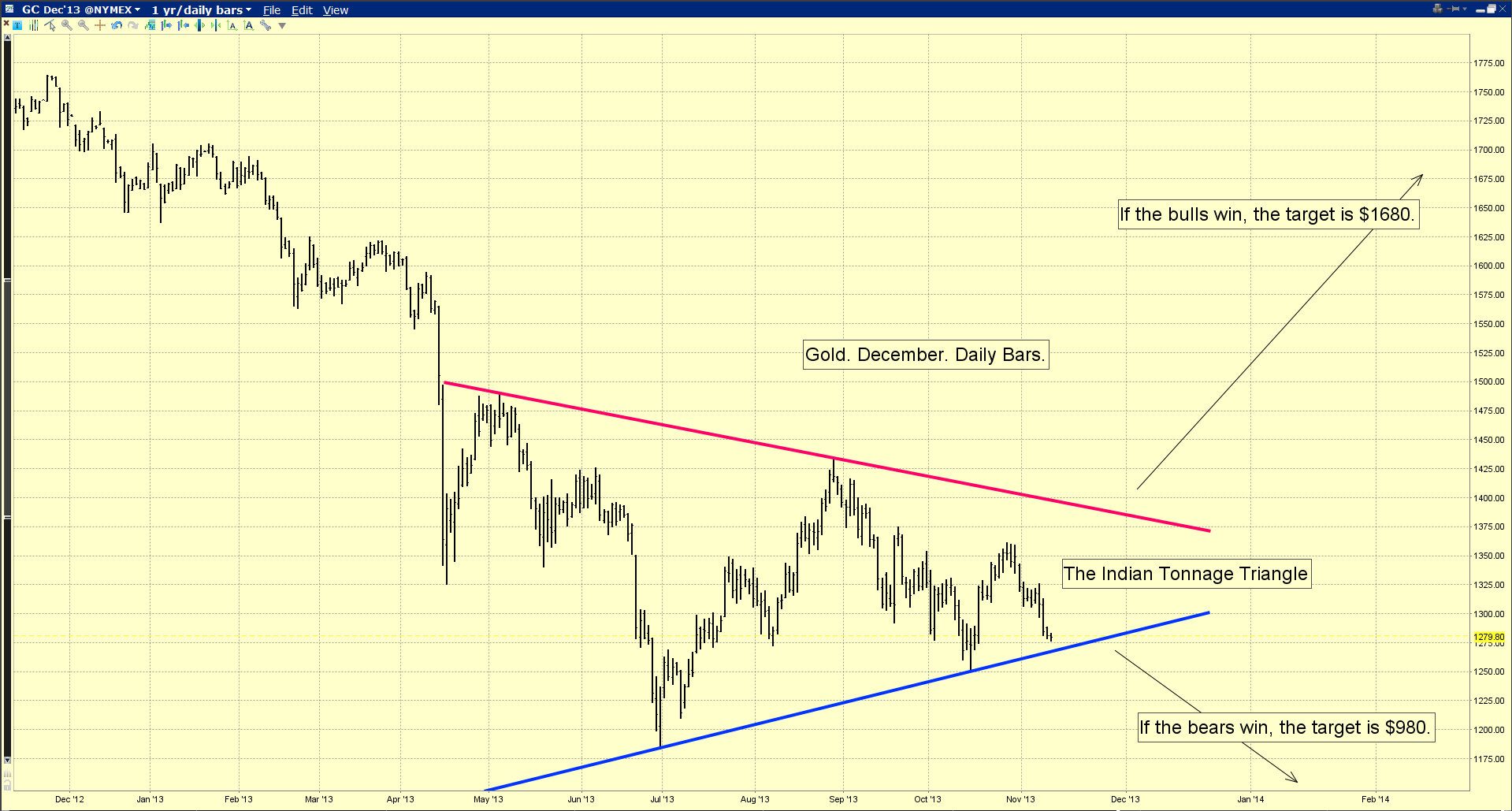 Please click here now or on the chart. That’s the daily gold chart, and I’ve highlighted an enormous symmetrical triangle pattern. I call it the “Indian Tonnage Triangle”, which may surprise gold analysts who believe the recent price action was caused by “taper caper” talk.
Please click here now or on the chart. That’s the daily gold chart, and I’ve highlighted an enormous symmetrical triangle pattern. I call it the “Indian Tonnage Triangle”, which may surprise gold analysts who believe the recent price action was caused by “taper caper” talk. -
To understand why I’ve given it that label, please click here now. In one of his famous movies, Clint Eastwood says, “A man’s got to know his limitations.” Unfortunately, I don’t think American gold bulls and bears understand their limitations, in regards to affecting the price of gold.
-
Please click here now. You are viewing a gold demand statistics table, courtesy of US Debt Clock.org. You can see that gold demand from Turkey is beginning to rival American gold demand, but the demand from both nations is relatively small. China and India are the “elephants in the gold room”.
-
CP Chidambaram is the finance minister of India, and he has successfully implemented draconian measures to reduce Indian gold imports.
-
Many Indian jewellery businesses have closed, and jewellery stock charts look like the Dow did in 1929. I don’t believe the actions or words of any Western entity are more relevant to gold right now than Indian tonnage numbers.
-
When an empire grows, the citizens of that empire get a feeling of great importance. When the empire dies, the citizens can believe the death of that empire must also be equally important. That’s not necessarily true.
-
The citizens of a dying empire may need to ask themselves some key questions. What happens if the death of the American empire is not that important to the price of gold anymore? What happens if the death of the American empire is becoming… irrelevant?
-
If an American fiat tree falls in an Asian physical gold forest, does it really make a sound?
-
If America is really becoming irrelevant to the price of gold, and India and China are now the key price drivers, the immediate question on every gold investor’s mind must be, “What can restore Indian gold imports to levels that push the price higher?”
-
For the possible answer to this critically important question, please click here now. Very few Indian politicians have made the cover of Time magazine, and Narendra Modi is one of them.
-
Indian national elections are scheduled to begin in May of 2014. Mr. Modi oversees the state of Gujarat. It has a population of 60 million, a 1% unemployment rate, a 10% GDP growth rate, a standard of living equal to Germany, and equity analysts in India have labelled the current Indian stock market price surge, the “the Modi rally”. They believe he will win the national election.
-
His home state of Gujarat is recognized as one of only two states in India where government corruption has been virtually eliminated.
-
Many Indians believe that Mr. Modi is a devout Hindu who views gold as a sacred metal. Regardless, if elected, the “Modi Man” has promised to dramatically reduce government corruption, which could open the door to an epic increase in foreign investment. That should eliminate India’s current account deficit surprisingly quickly.
-
Also, CP Chidambaram is getting old, and he has publicly stated that perhaps it is time for the old guard to retire.
-
Whether gold’s next big intermediate trend move is to $980 or $1680 should not be a concern for long term investors. Focus on the sizable and consistent growth of the middle class of India and China.
-
In the shorter term, liquidity flows on US futures markets will likely continue to be a key minor trend price driver. If you are an aggressive investor, please click here now. That’s another look at the daily gold chart, highlighting my key buy and sell zones.
-
I’ve recommended buying the $1266 area, and selling into $1350. That’s worked out pretty well. Note the superb position of my “stokeillator” (14,7,7 Stochastics series). The lead line is now at 20, which is bullish. A crossover buy signal seems to be imminent.
-
Please click here now. You are viewing the daily chart for XME-NYSE (SPDR SP Metals and Mining ETF). Its holdings include a number of the world’s biggest base metal mining companies. I expect some profits to be booked by institutional money managers, and those profits could flow to the more undervalued precious metal stocks. The strength of gold stocks over the past few trading sessions, compared to gold, suggests that process is underway now.
-
In China, the government is working hard to increase reform. Two hundred million Chinese citizens exist on wages of about one dollar a day. Despite all the growth so far, there is room for much more. As their wages rise, many will become eager gold buyers.
-
That gold is found and produced by Western mining companies. QE might get tapered, but does the Chinese and Indian middle class really care? They’re hungry for gold, and getting hungrier all the time!
Special Offer For Website Readers: Please send me an email to freereports4@gracelandupdates.com and I’ll send you my free “Jewel Of The West” report. I’ll show you the key technical events for Indian and Chinese jewellery stocks that could foreshadow a price spike in Western mining stocks!
Thanks!
Cheers
St
Note: We are privacy oriented. We accept cheques. And credit cards thru PayPal only on our website. For your protection. We don’t see your credit card information. Only PayPal does. They pay us. Minus their fee. PayPal is a highly reputable company. Owned by Ebay. With about 160 million accounts worldwide.
Written between 4am-7am. 5-6 issues per week. Emailed at aprox 9am daily.
Email: stewart@gracelandupdates.com
It may be hard to find someone as enthusiastic about precious metals mining as Sean Brodrick. A natural resource strategist with the Baltimore-based Oxford Club, an independent financial organization, Brodrick isn’t only filling his own portfolio with gold miners, he’s launching two new newsletters to research and vet resource stocks. While Brodrick might be putting his money where his mouth is, it’s not without solid reasoning and deep research, he explains in this interview with The Gold Report.
The Gold Report: Sean, over the next two months, you’ll be launching two different newsletters. The first one will be called Gold and Resource Trader. Why is now the right time to debut?
Sean Brodrick: It is a good idea because gold is generally hated right now. I like to look smart. One way to look smart is to buy things near a bottom and then hold onto them as they increase in value.
There is real value in the gold mining area. I ran a screen recently showing 25 miners trading on U.S. exchanges below book value. Some of them I wouldn’t buy, but some I would. This shows that real value is there. We are closer to the bottom than we were to the top, so now is a good time to get in.
TGR: Tell us about the second newsletter you’re going to launch in January?
SB: Oxford Resource Explorer is about energy, metals and other resources. It’s more energy focused because there are tremendous opportunities right now. If you told people 10 years ago that the U.S. would be producing at this level, you would have gotten some head shaking. They just wouldn’t have believed that.
The amazing stuff is what’s coming down the pike. The Gulf of Mexico is just kicking into high gear again. This shows how the natural resource market can turn on its head. People think they have the story figured out, and something comes along and changes the whole thing around. That’s why people are so bearish on gold. They think, well, that’s it, gold’s done; gold has had its day in the sun. No, it hasn’t. There are many good fundamental reasons for gold to go higher.
TGR: In some recent posts on your blog, King One Eye, you note that China is the driving force behind physical demand for gold, yet the central banks are on pace to buy almost half the gold they did in 2012. Does that trend concern you?
SB: Sure, it concerns me and it bears watching. But what the world’s central banks will buy is a guess. The proof is that Chinese demand for gold just keeps rising year over year. There’s extraordinary growth in China as millions join the middle class. And it’s not just China. There is lot of uplift in the whole economic atmosphere across Asia.
The central banks are important and I am absolutely keeping an eye on what they’re doing. But you have to understand why the central banks buy gold. They buy gold because they want to have something real and tangible, in case there’s ever a run on their currency or some other kind of financial crisis, to keep people from freaking out.
But there are some good reasons to freak out. We have quantitative easing, not just in the U.S. where it’s $85 billion/month, but around the world. The balance sheet of the whole of central banks system is now estimated to be more than $20 trillion by Bloomberg. Central banks keep buying gold because they are worried that some of those pigeons will come home to roost eventually.
TGR: Are higher gold prices necessary to make money in mining equities?
SB: Many companies do need the price of gold to go higher. Mining costs have been going up. Some companies that could make it on $400–500/ounce ($400–500/oz) during the last decade can’t anymore. There are low-cost miners out there. In fact, I love finding low-cost miners. Those are the companies I’ll be recommending to my subscribers in my new publication. But unless we see the price of gold go higher, we’re probably going to see even more large projects shut down.
Also, declining ore grades are putting pressure on companies. There used to be nice, rich gold ore that could be dug up cheaply. Now, companies are mining the gold ore that they used to drive over to get to the easy gold ore that they mined up. That’s the problem with gold. It’s a non-renewable resource. Ore grades are declining and costs are going up. That’s a one-two punch that means the price of gold needs to trend higher for companies to make money.
TGR: You’ve noted in your blog that you’re buying on the dips and pullbacks. What are you buying?
SB: What I’m seeking isn’t right for everyone. It depends on individual appetite for risk. Investors need to know their appetite for pain in an unforgiving market like this. If you don’t have an appetite for that, then you might just want to stick to exchange-traded funds (ETFs).
That said, I also like to buy individual companies because that’s where you’re really going to see the outperformance.
TGR: To that end then, Sean, you’re going to build a portfolio in Gold and Resource Trader. How are you going to structure it?
SB: I actually plan to include some of the larger caps. There are not that many large caps anymore. There are only about four mining companies that are still valued at more than $10B. I’ll also include the mid-cap range. But small caps are where I think the real value is.
I’m always looking for companies that have smart management so they can make it through hard times and reposition themselves for the next upswing.
TGR: What types of stories have caught your interest?
SB: There are such incredible values in producing miners that have exploration upside and will be likely adding to their resources and their production that I’m not picking up the developers at this point. I know some people are saying, “You should see how cheap the explorers are right now!” Yes, I know that. The explorers are super, super cheap. There are probably some that will do extraordinarily well, but I don’t need to raise my level of risk at this point. The producers are also so darn cheap, so why not just buy them?
TGR: But what about their all-in production costs?
SB: That’s a great point to bring up. I still see miners using cash costs of production. It makes me roll my eyes. I then have to go in and see what their all-in costs are. Investors know enough not to just go with the cash costs of production. They have to figure out what it is actually costing the miners by crunching the numbers.
Moreover, costs can fluctuate. For example, Mexico is going to move ahead with a 7.5% tax on miners. Now those companies will have to adjust their cost basis higher.
In this environment, some larger miners that had been planning on putting new projects into production when they thought the cost of gold was going to get to $2,000/oz very quickly are going to have to reassess. Many of them are also sitting on big, ol’ fat cash piles. They are going to buy these smaller producing miners that have resource upside and just move them right into their production pipelines. That’s one of the trends I hope to be playing because we will see some great mergers and acquisitions in that area.
TGR: That’s noteworthy because we certainly haven’t seen much of that to date.
SB: No, we haven’t. You can look at it two ways. No one is going to start doing mergers until the price goes higher. But the companies that wait that long aren’t really the ones you want to own. The miners you want to buy are the ones that are smart enough to buy something now, when things are so darn cheap and there are projects that are going for a song. They could be really mercenary and wait for another company to go out of business and then try to buy the project at a super-discount. But there’s no guarantee that they’ll actually get control of it because everybody is trying to do the same thing.
TGR: You’ll have more bidders.
SB: We’ll see some smart deals made at these prices because people will have their eye on the longer term. Smarter miners think about the longer term.
TGR: Are you still enthusiastic about Mexico as a jurisdiction given the impending tax situation?
SB: I was really keen on Mexico. We’ll have to see how that shakes out, though I think the bad news is priced in already.
Nicaragua is great. Parts of Canada are wonderful. You can get some real benefits for working in a place like Quebec that you can’t get somewhere else. I like parts of Africa as well. There are some opportunities in Turkey, Greece and Spain. They had historical mining and now they’re starting to examine those projects again.
Some places are heating up and you don’t want to go there—at least not at the present time. Nobody wanted to go to Peru when it had a really nasty political situation. Now it is becoming much more amenable to foreign investment. It’s actually looking like a good place to put money to work. On the other hand, Ecuador was pushed as the next place to be for a while. Now its government is getting kind of grabby. I wouldn’t want to be working in Ecuador right now.
The more politically upset the world gets and the more frothy with all this violence, new taxes, etc., the better North America looks. I think we have some great opportunities right around here.
TGR: What’s one helpful thought you can leave with our readers, Sean?
SB: The overall pessimism is overwhelming. I was speaking to a mining analyst recently—a sharp guy who has been at this for years. He was so pessimistic. He was talking about going off and doing something else because he just can’t take it anymore. When we see that kind of pessimism in anything, that’s a real contrary indicator that things might be about to move the other way.
There are three bullish forces for gold. First is global stimulus. We’re seeing the world’s central banks start to increase stimulus because they’re worried about economic growth as estimates have slowly lowered. Now, the banks are starting to pile in more stimulus. That generally tends to pump up the price of gold.
Second is selling by gold ETFs, which is starting to taper off. If that does taper off and end, then a major bearish force in the market will be lifted. That could really lift a weight off the price of gold rather quickly.
Third is the emerging middle class in Asia. It’s enormous. They want all the things we have, all the cars, the air conditioners, you name it, but they have a cultural affinity for gold. They don’t trust banks. That’s one thing they are going to buy.
You put those three things together and we could have a good year for gold in 2014.
TGR: Thanks for your time.
Sean Brodrick, a natural resources strategist for the Baltimore-based Oxford Club, travels far and wide seeking out investment values in the sector. A graduate of the University of Maine, Brodrick has more than 25 years of experience as a professional journalist and financial analyst. He is a regular contributor to InvestmentU.com and occasionally contributes to Dow Jones’ MarketWatch. Brodrick’s expertise has led to many financial talk show appearances. His book, “The Ultimate Suburban Survivalist Guide,” was published in 2010.
DISCLOSURE:
1) Brian Sylvester conducted this interview for The Gold Report and provides services to The Gold Report as an independent contractor.
2) Streetwise Reports does not accept stock in exchange for its services or as sponsorship payment.
3) Sean Brodrick: I was not paid by Streetwise Reports for participating in this interview. Comments and opinions expressed are my own comments and opinions. I had the opportunity to review the interview for accuracy as of the date of the interview and am responsible for the content of the interview.
4) Interviews are edited for clarity. Streetwise Reports does not make editorial comments or change experts’ statements without their consent.
5) The interview does not constitute investment advice. Each reader is encouraged to consult with his or her individual financial professional and any action a reader takes as a result of information presented here is his or her own responsibility. By opening this page, each reader accepts and agrees to Streetwise Reports’ terms of use and full legal disclaimer.
6) From time to time, Streetwise Reports LLC and its directors, officers, employees or members of their families, as well as persons interviewed for articles and interviews on the site, may have a long or short position in securities mentioned and may make purchases and/or sales of those securities in the open market or otherwise.
Streetwise – The Gold Report is Copyright © 2013 by Streetwise Reports LLC. All rights are reserved. Streetwise Reports LLC hereby grants an unrestricted license to use or disseminate this copyrighted material (i) only in whole (and always including this disclaimer), but (ii) never in part.
Streetwise Reports LLC does not guarantee the accuracy or thoroughness of the information reported.
Streetwise Reports LLC receives a fee from companies that are listed on the home page in the In This Issue section. Their sponsor pages may be considered advertising for the purposes of 18 U.S.C. 1734.
Participating companies provide the logos used in The Gold Report. These logos are trademarks and are the property of the individual companies.
Silver Money Flows Lead
Posted by Morris Hubbartt - Super Force Signals
on Friday, 8 November 2013 16:57
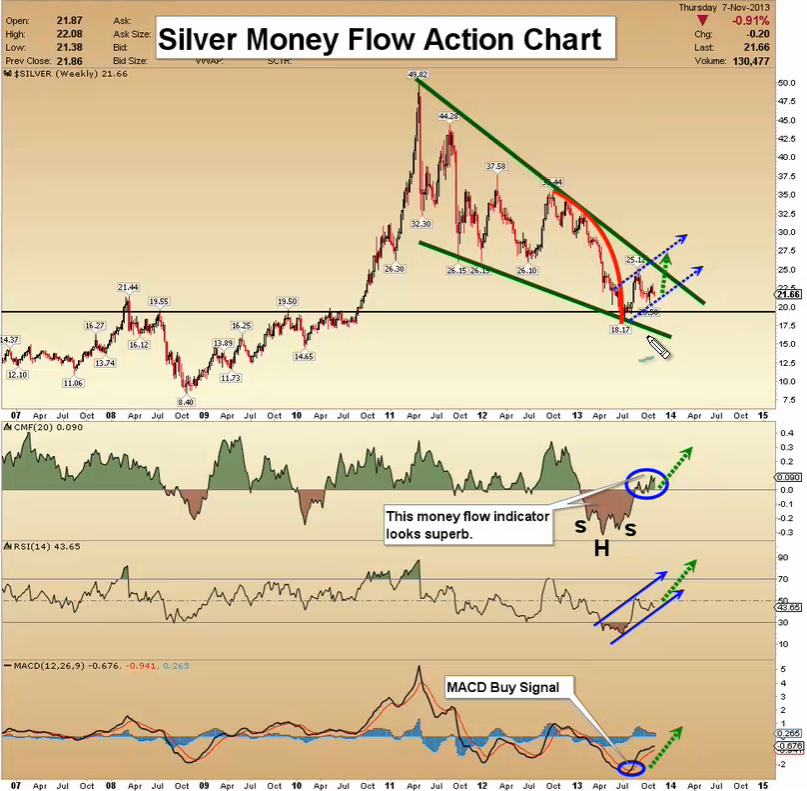
Here are today’s short punchy videos, roughly 1.25 minutes each – Ed
Silver Money Flow Action Chart
GDXJ Stokes Oscillator Update Chart
Thanks,
Morris
Unique Introduction For Web Readers: Send me an email to alerts@superforcesignals.com and I’ll send you 3 of my next
Super Force Surge Signals free of charge, as I send them to paid
subscribers. I’ll also send you my free “US Dollar Debt Clock” report. Thank you!
Top 10 Reasons To Buy Gold & Silver
Posted by Zerohedge via Peter Grandich
on Friday, 8 November 2013 15:00
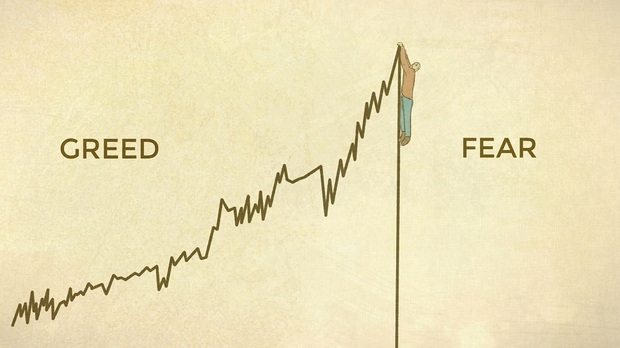 As Mike “Hidden Secrets Of Money” Maloney has said many times before, the economic crisis of 2008 was only a speed bump on the way to the main event. He believes that before the end of this decade there will be an economic crisis so historic that it will eclipse the crash of 29 and the subsequent great depression. He also believes it is both unavoidable and inevitable, because it is merely the free market releasing the stored up energy from decades of economic manipulation. As Maolney notes, “the best investment that you will ever make in your lifetime is your own financial education,” and the following provides a succinct reminder of the top reasons to buy gold and silver…
As Mike “Hidden Secrets Of Money” Maloney has said many times before, the economic crisis of 2008 was only a speed bump on the way to the main event. He believes that before the end of this decade there will be an economic crisis so historic that it will eclipse the crash of 29 and the subsequent great depression. He also believes it is both unavoidable and inevitable, because it is merely the free market releasing the stored up energy from decades of economic manipulation. As Maolney notes, “the best investment that you will ever make in your lifetime is your own financial education,” and the following provides a succinct reminder of the top reasons to buy gold and silver…
So here you go… a countdown of “The Top Ten Reasons That I Buy Gold And Silver.”
Ed Note: Great article with good visuals, for example the picture above is from number 5:
Gold Bear to End with a Bang
Posted by Jordan Roy-Byrne - The Daily Gold
on Thursday, 7 November 2013 13:48
For months we’ve been writing about the major bottom to come in precious metals. It appeared we finally saw it in late June as the metals and the stocks surged during the summer. Yet, these markets trailed off in August and it continued into October. The equities were down seven straight weeks. That gave way to an oversold bounce. Unless precious metals can close above their October highs on a weekly basis, the outlook remains bearish. While this bear market is finally coming to an end, don’t expect it to end quietly. At present Gold looks eerily similar to both Gold in 1976 and the SYP in 2009 prior to their major bottoms.
The first chart below shows Gold in 1975 to 1976. Gold’s sudden decline that began in August 1975 took it from over $160/oz down to $128/oz. It was a 20% drop in one month. After it rebounded it formed a marginal new low (A) and traded around $130 for about five months. Once Gold failed at the declining 50-day moving average and lateral resistance it plummeted to its final low.
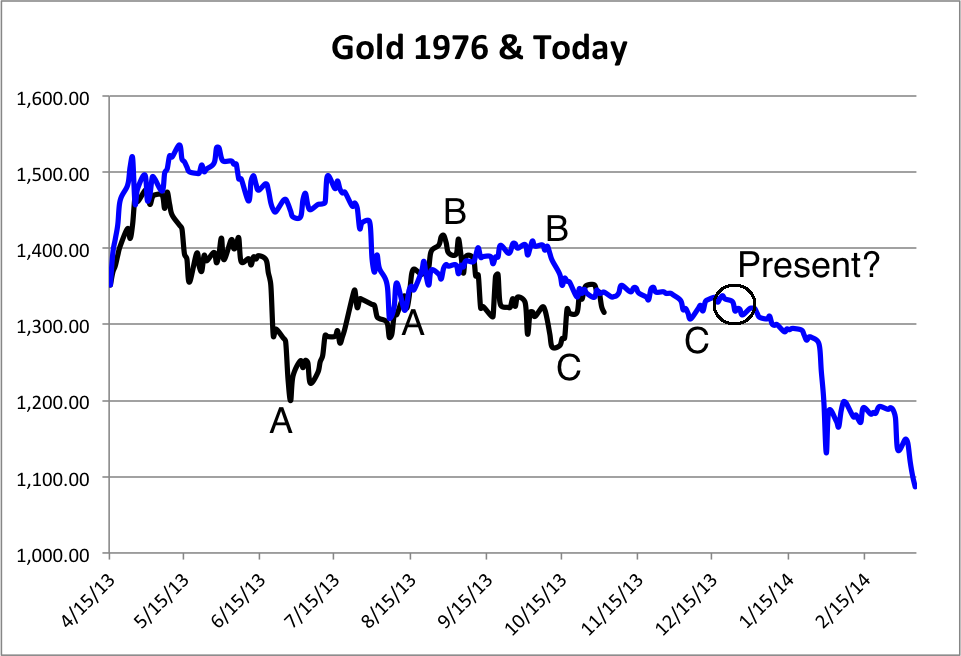
Gold in 2013 has formed a very similar pattern. The first panic low occurred in April which was followed by another low several months later. Gold then recovered back above the first panic low to point B. Point C labels the decline below the first panic low and a temporary bottom. Just like in summer 1976, Gold rallied up to a strong confluence of resistance (lateral and 50-day moving average) and failed.
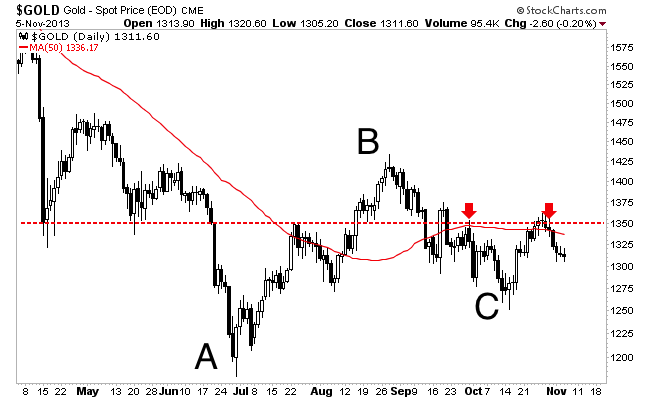
I’ve aligned both of the above plots on the same scale starting with their first panic low. The blue is Gold in 1975-1976 and the black is today. The 1976 template has Gold bottoming in early March. However, we can clearly see that Gold today is a few months ahead of that.
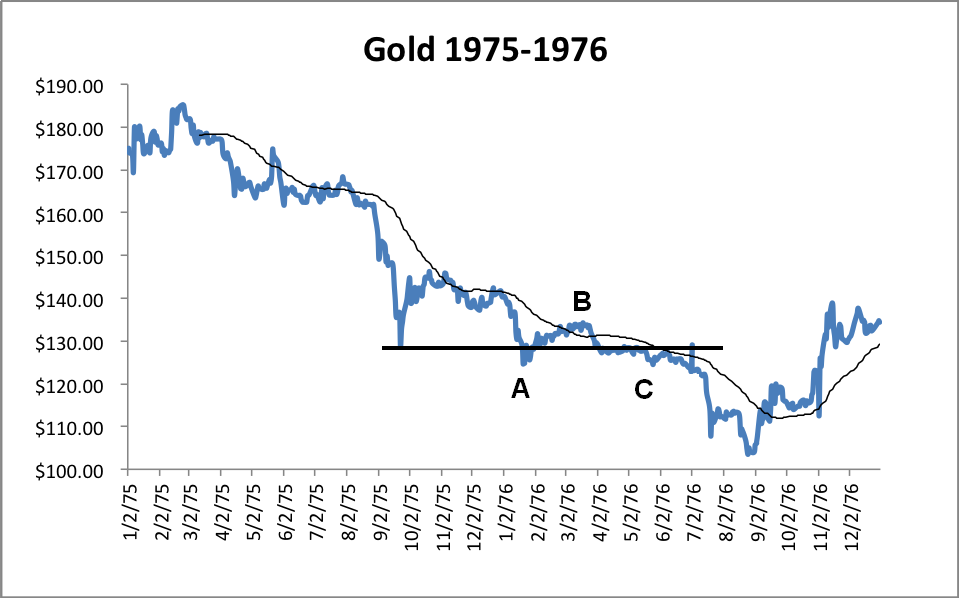
Next, take a look at the S&P bottom from 2008-2009. It followed the exact same pattern!
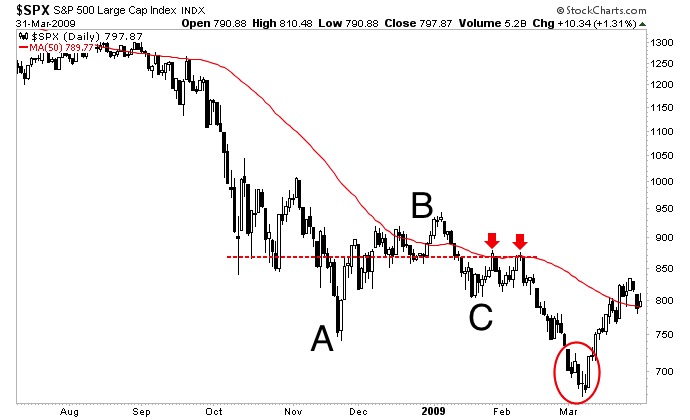
Let’s compare the three situations. In Gold from 1975-1976 its bearish consolidation (from first panic low to failure at resistance) lasted nine months and its final decline lasted two months. In the S&P 500 from 2008-2009 its bearish consolidation lasted only four months and its final decline lasted no more than four weeks. Gold’s bearish consolidation lasted about six and a half months. Judging from this data we could project Gold’s bottom to come in about six weeks.
There are a few more important things to note. Gold from 1975-1976 had a very weak rally from point A to B. It was in a weaker position and then consolidated for the longest. That is why it had the steepest final decline. The S&P in 2009 consolidated for only four months. When it broke to a new low, it made its final low the next week. Like the S&P 500, Gold today had a stronger rally from point A to B. Also, unlike the other two Gold today has been in a bear market for over two years. Considering these things, I’d expect Gold’s final bottom to be more similar to the S&P in 2009 than Gold in 1976.
How would this final decline in Gold affect the gold stocks?
The chart below is a monthly chart of the HUI gold bugs index and the NYSE gold miners index (GDM) which is the parent of the GDX ETF. Both markets bottomed in late June not to far above the major support which dates back to 2004. In fact, we referenced this chart when we penned an editorial, one day before the June bottom. Maybe Gold will break to a new low but the gold stocks won’t. If the gold stocks do make a new low, this chart is telling you that it won’t last for long. There is very strong support sitting right below the summer lows.
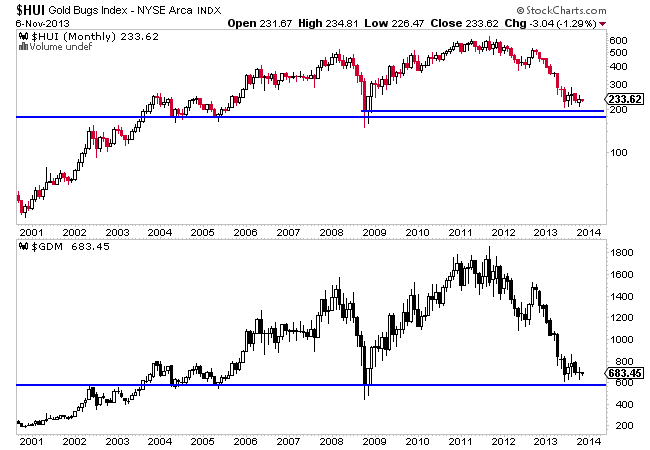
Unless Gold is able to close above $1350 in the near-term on a weekly basis then consider the short-term trend bearish. Gold looks set to plunge to its final bottom. Gold bugs will cry manipulation, CNBC and Twitter types will be mocking the Peter Schiffs of the world and many will be calling for $900 Gold. I urge you to avoid all this nonsense and focus on one thing. Get yourself in position to take advantage of this bottom. It’s the very smart money that is looking forward to buying this bottom. I suspect the coming bottom will be the one the typical huge rebounds originate from. If you’d be interested in this kind of analysis and the companies poised to rocket out of this bottom then we invite you to learn more about our service.
Good Luck!
Jordan Roy-Byrne, CMT
-
I know Mike is a very solid investor and respect his opinions very much. So if he says pay attention to this or that - I will.
~ Dale G.
-
I've started managing my own investments so view Michael's site as a one-stop shop from which to get information and perspectives.
~ Dave E.
-
Michael offers easy reading, honest, common sense information that anyone can use in a practical manner.
~ der_al.
-
A sane voice in a scrambled investment world.
~ Ed R.
Inside Edge Pro Contributors

Greg Weldon

Josef Schachter

Tyler Bollhorn

Ryan Irvine

Paul Beattie

Martin Straith

Patrick Ceresna

Mark Leibovit

James Thorne

Victor Adair



